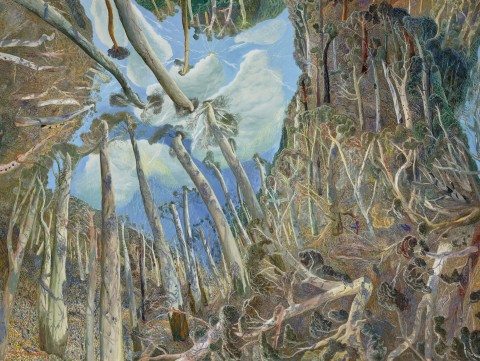SUNSHOWERS AND FLOOD GUMS, 1993
WILLIAM ROBINSON
oil on canvas
137.0 x 182.5 cm
signed and dated lower left: William Robinson 93
inscribed with title verso: SUNSHOWERS AND FLOOD GUMS
Ray Hughes Gallery, Sydney
Laverty collection, Sydney, acquired from the above in 1994
William Robinson, Ray Hughes Gallery, Sydney, 3 – 28 September 1994, cat. 17
Spirit and Place – Art in Australia 1861 – 1996, Museum of Contemporary Art, Sydney, 21 November 1996 – 31 March 1997 (illus. in exhibition catalogue, p. 52)
The Colin and Elizabeth Laverty Collection, Geelong Gallery, Victoria, 18 February – 15 April 2012
‘William Robinson’s Mature Perspective’, Sydney Morning Herald, Sydney, 10 September 1994, p. 34 (illus.)
Klepac, L., William Robinson, Paintings 1987 – 2000, The Beagle Press, Sydney, 2001, pl. 101, pp. 100 - 101 (illus., as ‘Sunshowers and Flooded Gums’), 202
‘In relation to a sense of place, William Robinson has made a unique contribution to the Australian landscape tradition, moving beyond conventional notions to encompass a fluctuating environment; of rainforest and ocean, ground and sky, day and night, elemental forces of wind, lightning, rain and fire. His multidimensional grasp of time and space also suggests metaphors for states of mind and being, life and death, continuity and transcendence. The profound spiritual resonances in Robinson’s art remind us of the need to preserve an ancient natural world in the present; ‘to keep the faith’, as Simon Schama wrote in Landscape and Memory, ‘with a future on this tough, lovely old planet’’.1
Robinson’s treatment of the horizon and distorted perspective set him apart from his contemporaries. While many Australian landscape painters traditionally looked towards the arid interior for inspiration, he embraces the lush south- eastern Queensland mountain ranges. The dramatic features of the granite belt, with its soaring cliffs, meandering rivers, creeks and waterfalls, offer the perfect subject for Robinson to flaunt his painterly innovations.
The steep ravines, high annual rainfall and proximity to the coast combine to provide dramatic weather shifts, which Robinson exploits wilfully. As the title of Sunshowers and Floodgums, 1993 suggests, it is the ephemeral beauty of this landscape which captivates the artist. He gives equal weight to the physical grandeur of the ancient forms, as he does to the intangible elements of light, mist, mood and atmosphere.
In the act of painting there is a tipping point where the image takes over and a seamless synergy occurs between the artist, their materials and subject. The artist becomes the vehicle for the work and almost takes a backseat as the painting evolves in inspired revelation. Artists sometimes refer to a work as ‘painting itself’ when describing this shaman-like relationship between the artist and subject. Robinson arrives at this point early and you can feel the urgency his works attain as they reach toward a higher state of observation and translation. Each new painting builds on the achievements of the previous one as he pushes the boundaries of his artistic abilities and the conventions of landscape painting.
This state of oneness with his work is achieved by continuous immersion in the act of creation and Robinson typically works every day, all day – except Sundays. God rested on the Sabbath and so does Robinson, reserving this day for reflection and music in humble observance of the Maker’s achievements. The artist is a deeply spiritual man, and his paintings are to be viewed as a personal homage to the creator. The current example conveys this more than others, with the central focus of painting being towards the sun-dappled blue skies streaming through the towering floodgums. Like the Renaissance masters Robinson so much admires, he looks to the heavens for the essence of his inspiration.
1. Hart, D., ‘William Robinson’s artistic development: An intimate and expansive journey’ in William Robinson, A Transfigured Landscape, Queensland University of Technology and Piper Press, Brisbane, 2011, p. 38
HENRY MULHOLLAND
